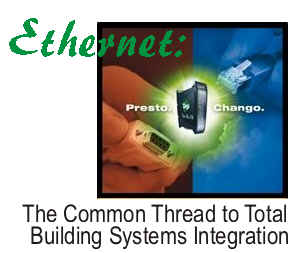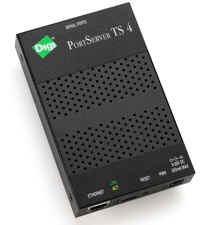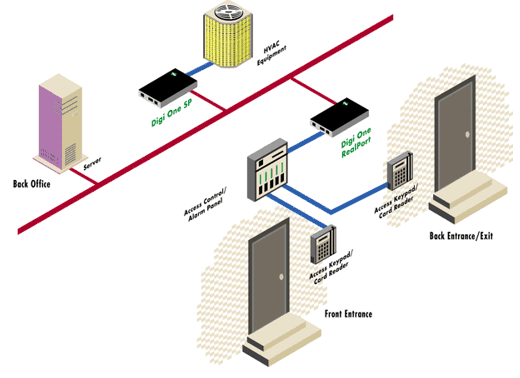
|
Jason
Sprayberry |
AutomatedBuildings.com
|
[an error occurred while processing this directive] |

|
Jason
Sprayberry |
Ever notice how each Building Automation vendor boasts open architecture and interconnectivity? In fact, this claim usually means they openly connect to only devices they sell/support. Adding legacy equipment like protocols, mediums and connectors into the mix only exacerbates this problem. It's enough to frustrate the most seasoned integrators. However, a phoenix is rising from the ashes in the form of Ethernet to offer promise and hope for easing the plight of interconnectivity.
|
[an error occurred while processing this directive] |
Ethernet Made Easy
Ethernet is a low cost, high speed, widely deployed, universally accepted medium
for local area and wide area networks. Layer on top the TCP/IP protocol, the
most common office networking language (as well as the language of the Internet)
and you have the initial ingredients of an open, more easily integrated system.
Of course, no solution is perfect and Ethernet has its drawbacks. However, most of Ethernet's weaknesses have been aptly addressed making it increasingly accepted in scenarios where it may have been rejected in the past. For example, critics have pointed to its lack of rugged components, non-determinism, and vendor acceptance. But, industrial grade switches, cables and connectors compensate for these fallbacks, and vendors are quickly adopting Ethernet as the new communication standard.
You may be saying, "Well just putting an RJ45 Ethernet port on a device does not make it interoperable with other systems." This is true. However, this first step of standardizing media, infrastructure, and application communications certainly makes the road easier to travel.
Linking Legacy
Systems
One of the remaining challenges is connecting legacy systems to this world.
This is a little like trying to put a jet engine into a model T, but such
technology does exist. Take device servers for example. They are an ingenious
solution that allows serial devices to communicate over IP networks. Many legacy
devices from each building automation segment tend to have RS-232, 422, or 485
serial ports on board. For example, in HVAC, there are VAV's and Building
Controllers. Security has control panels and card readers. In utilities, relays
and meters tend to have serial ports. Phone systems have serial ports on their
PBX's. Even lighting, time and attendance, fire, elevators and so on have serial
interfaces, which can be connected to Ethernet using device server technology.
The key resides in separating the wheat from the chaff. Many device servers only provide basic serial encapsulation over TCP/IP; however, some vendors go the extra mile to provide a solution for building automation needs. One consideration is the number of serial devices that reside in a local area. Device servers and terminal servers are available with 1, 2, 4, 8, 16, 32 serial ports or more. While several offerings operate in environmentally protected areas, a new breed of device servers are available that operate in more challenging temperatures like -35 to +75 C. A rugged metal housing and several mounting options (wall, dinrail or 19" rack) allow units to fit almost anywhere.
Some of the most important requirements, however, are inside the box. Ease of setup/configuration/use as well as connectivity options are key factors when considering a device server for your building automation application. Top notch serial to Ethernet products include software that automatically discovers device servers and makes IP assignment a snap. Look for embedded Web servers for configuration and wizards to make the process easier and quicker.
Connectivity Concerns
[an error occurred while processing this directive]For
connectivity options, the most basic feature is called raw socket. The device
server simply encapsulates the serial data into IP packets and hopes that the
receiving application or device on the network knows how to handle this
information. The problem is that very few applications or devices installed in
the BAS world today actually support a raw TCP/IP connection.
This is where device servers really begin to differ. A key requirement for many applications that involve a PC connection to a serial device over Ethernet is called COM Port Redirection software. The best-of- breed vendors offer software that runs as a driver on the host computer to create a "Virtual COM Port," which allows any application that normally communicates with a serial device via a COM port to now communicate over the Ethernet to the end device as if it were a COM connection. This is done by mapping a "Virtual Com Port" (say COM 10) to the IP address of the device server.
Another type of connection is called a Serial Tunnel. The premise is that two device servers are used as a serial cable extension. One device server connects to a serial device at one end and routes the serial data over Ethernet to another device server at the opposite end where the data from Ethernet is converted back to serial.
 Above and Beyond
Above and Beyond
Another type of device server goes a step further to create a protocol-aware
"intelligent gateway" that converts one type of serial protocol to its
Ethernet equivalent. An example of a popular gateway function is converting
Modbus serial (ASCII or RTU) to ModbusTCP. This function allows any application
or device that uses ModbusTCP as its primary protocol to communicate natively
with a serial Modbus device.
Latency is another concern. When serial data is turned into Ethernet packets, latency can become an issue. Applications that worked just fine when plugged directly into a PC COM port suddenly behave erratically or don't work at all when connected to a device server. Only a few device servers that support a "low latency" mode can successfully communicate with virtually any serial protocol.
Of course, wireless requirements are becoming more prevalent today. Careful research will uncover only a few vendors that actually convert serial data into WiFi (802.11b) signals, which allow users to throw away the Ethernet cables altogether.
At least one company meets all of the device server requirement needs. Digi International, based in Minnetonka, MN, has honed its serial connectivity skills since 1985. Today, offerings targeting the Building Automation space include its line of serial to Ethernet products like Digi One TS and PortServer TS products, as well as its Digi One SP and IA device servers.

Lester Karplus of Time Centre used Digi device servers in his Time and Attendance application. According to Karplus: "It allowed us to add IP connectivity where we did not have it before and to solve some problems where the IP solution we had was not adequate. Digi products are well designed and integrated quickly and easily into our application."
Of course, no one product will solve all of your connectivity needs, but as Ethernet creeps its way into your facility, your choices will continue to grow. And as long as you utilize legacy equipment, those serial devices will continue to require TCP/IP integration, for which today, there is no better solution than device servers.
[an error occurred while processing this directive]
[Click Banner To Learn More]
[Home Page] [The Automator] [About] [Subscribe ] [Contact Us]